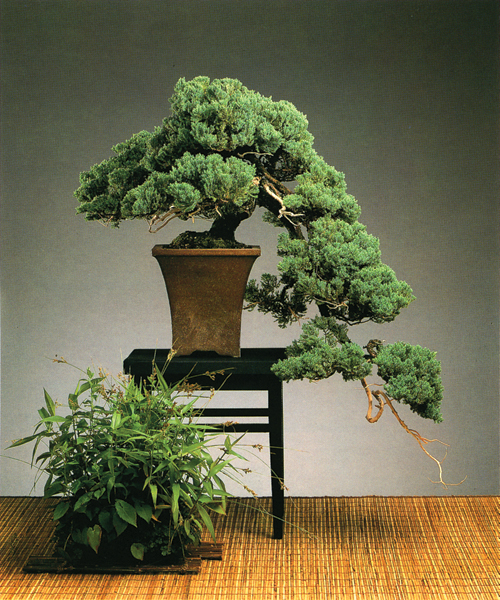 The caption from our Juniper book and our original post back in 2010 says “Shore Juniper (J. procumbens)” but that just can’t be. If it’s a Shore juniper, then it’s J. conferta. If it’s a J procumbens then you have to decide if it’s the common ‘Nana’ variety or another variety of procumbens. If it’s another variety of procumbens then the whole naming game is a little more confusing.
The caption from our Juniper book and our original post back in 2010 says “Shore Juniper (J. procumbens)” but that just can’t be. If it’s a Shore juniper, then it’s J. conferta. If it’s a J procumbens then you have to decide if it’s the common ‘Nana’ variety or another variety of procumbens. If it’s another variety of procumbens then the whole naming game is a little more confusing.
In any case, this stunning juniper bonsai is by master bonsai innovator, Masahiko Kimura. It combines the sculptural look that has been favored by some Japanese bonsai artists (especially in the 90s) with a more wild, rugged natural look that is in favor in much of the world bonsai community. Not that bonsai is so simple that it can be divided into two categories; sculptural versus natural. If bonsai is an art, then categories are continually being broken down as artist play, explore and innovate. And no bonsai artist that I know of, has played, explored and innovated more successfully than The Magician, Masahiko Kimura. Photo is from our Juniper book.
Continuing mid-summer semi-vacation time, I’m taking the easy way out once again. This post (edited a bit now) originally appeared way back in January 2010, which means for most of you it is either long forgotten or never seen, so no harm in bringing it back.
What is it about junipers?
Junipers are tough, durable, flexible (they take to wire like they were made for it) and pruneable. They don’t mind having their roots pruned (sometime quite heavily) and they take to container culture. Their needles tend to be small and dense and both their needles and bark come in a range of attractive (sometimes luminous) colors and textures. Perhaps best of all, junipers take to carving like few other plants; and their deadwood is both attractive and long lasting (all deadwood eventually rots, but juniper wood rots more slowly than most), especially if you keep it clean and apply lime sulfur.
Everywhere and for everyone
Junipers grow almost everywhere in the northern hemisphere (they don’t occur south of the equator), from the Arctic tundra to the Central American mountains and African tropics. This means that there are varieties for almost any climate, including some that can survive indoors (only under just the right conditions, with the emphasis on survive, rather than on grow; as indoor cultivation is tough on most plants – but that’s a story for another time). All this makes junipers a first choice for bonsai, from beginners all the way to the masters.

Dwarf Japanese garden juniper (J. procumbens ‘Nana’). By Jerald B. Stowell. From Bonsai Today issue 26. Procumbens nana is by far the most popular juniper for beginners, at least here in the States (it’s the one you see ad nauseam in the malls around the Holidays). However, you seldom see a masterpiece, as the trunks tend to stay too thin. The trunk on this one is about a thick as I’ve ever seen.
I love Jerald Stowell’s bonsai book, the Beginner’s Guide to American Bonsai. Few American bonsai authors really did accent plants well, as he did. (Probably his association with Kyuzo Murata influenced this.) Looking through that book I have often wondered how those trees have progressed and if he’s still around.
… It looks like Stowell passed away. Per internet obituary: Jerald P. Stowell was born on June 9, 1927 and passed away on Sunday, April 25, 2010. Jerald was a resident of Flemington, New Jersey.